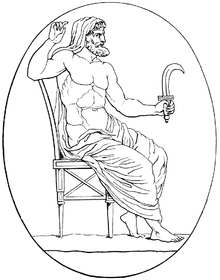குரோனசு: திருத்தங்களுக்கு இடையிலான வேறுபாடு
No edit summary |
No edit summary |
||
| வரிசை 42: | வரிசை 42: | ||
{{chart|border=0| |!| | | | |:| |!| | |!|BBB |BBB= b <ref>According to Hesiod, ''Theogony'' [http://www.perseus.tufts.edu/hopper/text?doc=Hes.+Th.+927 927–929], Hephaestus was produced by Hera alone, with no father, see Gantz, p. 74.</ref>}} |
{{chart|border=0| |!| | | | |:| |!| | |!|BBB |BBB= b <ref>According to Hesiod, ''Theogony'' [http://www.perseus.tufts.edu/hopper/text?doc=Hes.+Th.+927 927–929], Hephaestus was produced by Hera alone, with no father, see Gantz, p. 74.</ref>}} |
||
{{chart| |!| | | | |:| |!| | |!| |!}} |
{{chart| |!| | | | |:| |!| | |!| |!}} |
||
{{chart| |!| | | | |:|ARE | |HEP |HEP=[[எப்பெசுடசு]]|ARE=[[ |
{{chart| |!| | | | |:|ARE | |HEP |HEP=[[எப்பெசுடசு]]|ARE=[[ஏரெசு]]}} |
||
{{chart| |!| | | | |D|~|~|~|y|~|~|~|~|MET |MET=மெட்டீசு}} |
{{chart| |!| | | | |D|~|~|~|y|~|~|~|~|MET |MET=மெட்டீசு}} |
||
{{chart| |!| | | | |:| | |ATH |ATH=[[அத்தீனா]] <ref>According to Hesiod, ''Theogony'' [http://www.perseus.tufts.edu/hopper/text?doc=Hes.+Th.+886 886–890], of Zeus' children by his seven wives, Athena was the first to be conceived, but the last to be born; Zeus impregnated Metis then swallowed her, later Zeus himself gave birth to Athena "from his head", see Gantz, pp. 51–52, 83–84.</ref>}} |
{{chart| |!| | | | |:| | |ATH |ATH=[[அத்தீனா]] <ref>According to Hesiod, ''Theogony'' [http://www.perseus.tufts.edu/hopper/text?doc=Hes.+Th.+886 886–890], of Zeus' children by his seven wives, Athena was the first to be conceived, but the last to be born; Zeus impregnated Metis then swallowed her, later Zeus himself gave birth to Athena "from his head", see Gantz, pp. 51–52, 83–84.</ref>}} |
||
| வரிசை 55: | வரிசை 55: | ||
{{chart|border=0|AAA | | | | | | | |BBB|AAA= a <ref>According to Hesiod, ''Theogony'' [http://www.perseus.tufts.edu/hopper/text?doc=Hes.+Th.+183 183–200], Aphrodite was born from Uranus' severed genitals, see Gantz, pp. 99–100.</ref>|BBB= b <ref>According to Homer, Aphrodite was the daughter of Zeus (''Iliad'' [http://data.perseus.org/citations/urn:cts:greekLit:tlg0012.tlg001.perseus-eng1:3.374 3.374], [http://data.perseus.org/citations/urn:cts:greekLit:tlg0012.tlg001.perseus-eng1:20.105 20.105]; ''Odyssey'' [http://data.perseus.org/citations/urn:cts:greekLit:tlg0012.tlg002.perseus-eng1:8.308 8.308], [http://data.perseus.org/citations/urn:cts:greekLit:tlg0012.tlg002.perseus-eng1:8.320 320]) and Dione (''Iliad'' [http://data.perseus.org/citations/urn:cts:greekLit:tlg0012.tlg001.perseus-eng1:5.370 5.370–71]), see Gantz, pp. 99–100.</ref>}} |
{{chart|border=0|AAA | | | | | | | |BBB|AAA= a <ref>According to Hesiod, ''Theogony'' [http://www.perseus.tufts.edu/hopper/text?doc=Hes.+Th.+183 183–200], Aphrodite was born from Uranus' severed genitals, see Gantz, pp. 99–100.</ref>|BBB= b <ref>According to Homer, Aphrodite was the daughter of Zeus (''Iliad'' [http://data.perseus.org/citations/urn:cts:greekLit:tlg0012.tlg001.perseus-eng1:3.374 3.374], [http://data.perseus.org/citations/urn:cts:greekLit:tlg0012.tlg001.perseus-eng1:20.105 20.105]; ''Odyssey'' [http://data.perseus.org/citations/urn:cts:greekLit:tlg0012.tlg002.perseus-eng1:8.308 8.308], [http://data.perseus.org/citations/urn:cts:greekLit:tlg0012.tlg002.perseus-eng1:8.320 320]) and Dione (''Iliad'' [http://data.perseus.org/citations/urn:cts:greekLit:tlg0012.tlg001.perseus-eng1:5.370 5.370–71]), see Gantz, pp. 99–100.</ref>}} |
||
{{chart| |`|-|-|-|-|-|-|-|.| |!}} |
{{chart| |`|-|-|-|-|-|-|-|.| |!}} |
||
{{chart| | | | | | | | | |APH |APH=[[ |
{{chart| | | | | | | | | |APH |APH=[[அப்ரோடிட்]]}} |
||
{{chart/end}} |
{{chart/end}} |
||
{{chart bottom}} |
{{chart bottom}} |
||
06:20, 2 மார்ச்சு 2018 இல் நிலவும் திருத்தம்
| குரோனசு | |
|---|---|
 | |
| இடம் | ஓத்ரைசு மலைச்சிகரம் |
| துணை | ரியா |
| பெற்றோர்கள் | யுரேனசு மற்றும் கையா |
| சகோதரன்/சகோதரி | டைட்டன்கள், எகாடோஞ்சிர்கள், கைகான்ட்சுகள், சைக்ளோப்சுகள், அப்ரடைட்டி, டைப்போன் மற்றும் பைத்தான் |
| குழந்தைகள் | சியுசு, எரா, பொசைடன், ஏடிசு, எசிடியா, டிமிடர், கைரன் |
குரோனசு என்பவர் கிரேக்கத் தொன்மவியலில் கூறப்படும் பன்னிரு டைட்டன்களுள் ஒருவரும் டைட்டன் தலைவரும் ஆவார். இவருக்கு இணையான ரோமக் கடவுள் சற்றேன் ஆவார். இவர் தன் தந்தை யுரேனசை வீழ்த்தி ஆட்சியைப் பிடித்தார். அதன் பிறகு குரோனசின் மகன் சியுசு அவரை வீழ்த்தி பாதாள உலகமான டார்டரசில் சிறை வைத்தார்.
குரோனசின் எழுச்சி
யுரேனசு மற்றும் கையாவிற்கு நூறு கைகள் கொண்ட எகாடோஞ்சிர்கள், ஒற்றைக் கண் கொண்ட சைக்ளோப்சுகள் மற்றும் பெரிய உருவம் கொண்ட கைகான்ட்சுகள் என்னும் அரக்கர்கள் போன்ற வலிமை மிகுந்த பிள்ளைகள் பிறந்தனர். இதனால் பயந்த யுரேனசு அவர்களை கையாவிற்குத் தெரியாமல் பாதாள உலகமான டார்டரசில் மறைத்து வைத்தார். அவர்கள் பாதாளத்தில் இருந்து கொண்டு கையாவிற்கு துன்பம் தந்தனர். இதனால் உண்மையை அறிந்த கையா யுரேனசு மீது கோபம் கொண்டு கல்லால் ஒரு அரிவாள் செய்தார். அதைக் கொண்டு யுரேனசை வீழ்த்துமாறு தன் டைட்டன் பிள்ளைகளிடம் கொடுத்தார். ஆனால் அவர்கள் பயந்து பின்வாங்கினர். பிறகு குரோனசு மட்டும் தைரியமாக முன்வந்து அந்த அரிவாளை எடுத்தார். யுரேனசு கையாவுடன் உறவாட முயன்றபோது அவரின் பிறப்புறுப்பை வெட்டி குரோனசு கடலில் வீசியெறிந்தார். அதில் இருந்து பொங்கிய நுரையில் இருந்து கடவுள் அப்ரோடிட் பிறந்ததாகக் கூறப்படுகிறது.
பிறகு கையாவின் பிள்ளைகளை டார்டரசில் இருந்து விடுவித்தார் குரோனசு. ஆனால் அவர்களின் அசுர வலிமையால் தன்னை வீழ்த்தி ஆட்சிக்கு வந்துவிடுவார்களோ என்று பயந்த குரோனசு மீண்டும் அவர்களை பாதாளத்தில் அடைத்தார். மேலும் அவர்களைக் காவல் காக்க கேம்பே என்னும் பெண் டிராகனை உருவாக்கினார். குரோனசின் ஆட்சி பொற்காலம் என்று அழைக்கப்பட்டது. ஏனெனில் அவரது ஆட்சியில் அனைவரும் நன்மைகளையே செய்து வந்தனர்.
குரோனசின் வீழ்ச்சி
தன் தந்தை யுரேனசை வீழ்த்தி ஆட்சியைப் பிடித்த குரோனசு அதே நிலை தனக்கும் நேரும் என்று தன் பெற்றோர் மூலம் அறிந்து கொண்டார். அதனால் தனக்குப் பிறந்த எரா, எசுடியா, டிமிடர், பொசைடன் மற்றும் ஏடிசு ஆகிய ஐந்து குழந்தைகளையும் விழுங்கி விட்டார். ஆறாவது குழந்தையாகப் பிறந்த சியுசை அவரது தாய் ரேயா காப்பாற்ற நினைத்தார். அதற்காக கையா ஒரு திட்டம் தீட்டினார். அதன்படி ரேயா ஒரு கல்லில் துணியைச் சுற்றி குழந்தை என்று கூறி குரோனசை ஏமாற்றிவிடுகிறார். பிறகு க்ரீட் தீவில் உள்ள இடா மலைச்சிகரத்தின் குகையில் சியுசை மறைத்து வைத்துவிட்டுச் சென்றார் ரேயா. அதன் பிறகு சியுசை கையா வளர்த்ததாகக் கூறப்படுகிறது.
சியுசு ஆடவனாக வளர்ந்ததும் தன் தந்தை குரோனசின் வயிற்றை கிழித்து தன் சகோதரர்களை விடுவித்தார். சில கதைகளில் ஓசனசின் மகளான மெட்டிசு என்பவர் கொடுத்த மருந்தை உட்கொண்டதால் குரோனசு வாந்தி எடுத்ததாகவும் அதன்மூலம் சியுசின் சகோதரர்கள் விடுபட்டதாகவும் கூறப்படுகிறது. பிறகு சியுசு பாதாள உலகமான டார்டரசுக்குச் சென்றார். அங்கு காவலன் கேம்பேயை கொன்று கையாவின் அசுர பிள்ளைகளான கைகான்ட்சுகள், எகாடோஞ்சிர்கள் மற்றும் சைக்ளோப்சுகள் ஆகியவர்களை விடுவித்தார். பிறகு அவர்களுடன் இணைந்து சியுசும் அவரது சகோதரர்களும் டைட்டன்களை வீழ்த்தினர். இந்த போர் டைடனோமாச்சி என அழைக்கப்படுகிறது. பிறகு தோற்ற டைட்டன்கள் அனைவரும் டார்டரசில் அடைக்கப்பட்டனர். ஆனால் ஓசனசு, ஈலியோசு, அட்லசு, ப்ரோமித்தியுசு, எபிமித்தியூசு மற்றும் மினொயித்தியசு ஆகியோர் மட்டும் அடைக்கப்படவில்லை.
வம்சாவளி
| குரோனசின் வம்சாவளி [1] | |||||||||||||||||||||||||||||||||||||||||||||||||||||||||||||||||||||||||||||||||||||||||||||||||||||||||||||||||||||||||||||||||||||||||||||||||||||||||||||||||||||||||||||||||||||||||||||||||||||||||||||||||||||||||||||||||||||||||||||||||||||||||||||||||||||||||||||||||||||||||||||||||||||||||||||||||||||||||||||||||||||||||||||||||||||||||||||||||||||||||||||||||||||||||||||||||||||||||||||||||||||||||||||||||||||||||||||||||||||||||||||||||||||||||||||||||||||||||||||||||||||||||||||||||||||||||||||||||||||||||||||||||||||||||||||||||||||||||||||||||||||||||||||||||||||||||||||||||||||||||||||||||||||||||||||||||||||||||||||||||||||||||||||||||||||||||||||||||||||||||||||||||||||||||||||||||||||||||||||||||||||||||||||||||||||||||||||||||||||||||||||||||||||||||||||||||||||||||||||||||||||||||||||||||||||||||||||||||||||||||||||||||||||||||||||||||||||||||||||||||||||||||||||||||||||||||||||||||||||||||||||||||||||||||||
|---|---|---|---|---|---|---|---|---|---|---|---|---|---|---|---|---|---|---|---|---|---|---|---|---|---|---|---|---|---|---|---|---|---|---|---|---|---|---|---|---|---|---|---|---|---|---|---|---|---|---|---|---|---|---|---|---|---|---|---|---|---|---|---|---|---|---|---|---|---|---|---|---|---|---|---|---|---|---|---|---|---|---|---|---|---|---|---|---|---|---|---|---|---|---|---|---|---|---|---|---|---|---|---|---|---|---|---|---|---|---|---|---|---|---|---|---|---|---|---|---|---|---|---|---|---|---|---|---|---|---|---|---|---|---|---|---|---|---|---|---|---|---|---|---|---|---|---|---|---|---|---|---|---|---|---|---|---|---|---|---|---|---|---|---|---|---|---|---|---|---|---|---|---|---|---|---|---|---|---|---|---|---|---|---|---|---|---|---|---|---|---|---|---|---|---|---|---|---|---|---|---|---|---|---|---|---|---|---|---|---|---|---|---|---|---|---|---|---|---|---|---|---|---|---|---|---|---|---|---|---|---|---|---|---|---|---|---|---|---|---|---|---|---|---|---|---|---|---|---|---|---|---|---|---|---|---|---|---|---|---|---|---|---|---|---|---|---|---|---|---|---|---|---|---|---|---|---|---|---|---|---|---|---|---|---|---|---|---|---|---|---|---|---|---|---|---|---|---|---|---|---|---|---|---|---|---|---|---|---|---|---|---|---|---|---|---|---|---|---|---|---|---|---|---|---|---|---|---|---|---|---|---|---|---|---|---|---|---|---|---|---|---|---|---|---|---|---|---|---|---|---|---|---|---|---|---|---|---|---|---|---|---|---|---|---|---|---|---|---|---|---|---|---|---|---|---|---|---|---|---|---|---|---|---|---|---|---|---|---|---|---|---|---|---|---|---|---|---|---|---|---|---|---|---|---|---|---|---|---|---|---|---|---|---|---|---|---|---|---|---|---|---|---|---|---|---|---|---|---|---|---|---|---|---|---|---|---|---|---|---|---|---|---|---|---|---|---|---|---|---|---|---|---|---|---|---|---|---|---|---|---|---|---|---|---|---|---|---|---|---|---|---|---|---|---|---|---|---|---|---|---|---|---|---|---|---|---|---|---|---|---|---|---|---|---|---|---|---|---|---|---|---|---|---|---|---|---|---|---|---|---|---|---|---|---|---|---|---|---|---|---|---|---|---|---|---|---|---|---|---|---|---|---|---|---|---|---|---|---|---|---|---|---|---|---|---|---|---|---|---|---|---|---|---|---|---|---|---|---|---|---|---|---|---|---|---|---|---|---|---|---|---|---|---|---|---|---|---|---|---|---|---|---|---|---|---|---|---|---|---|---|---|---|---|---|---|---|---|---|---|---|---|---|---|---|---|---|---|---|---|---|---|---|---|---|---|---|---|---|---|---|---|---|---|---|---|---|---|---|---|---|---|---|---|---|---|---|---|---|---|---|---|---|---|---|---|---|---|---|---|---|---|---|---|---|---|---|---|---|---|---|---|---|---|---|---|---|---|---|---|---|---|---|---|---|---|---|---|---|---|---|---|---|---|---|---|---|---|---|---|---|---|---|---|---|---|---|---|---|---|---|---|---|---|---|---|---|---|---|---|---|---|---|---|---|---|---|---|---|---|---|---|---|---|---|---|---|---|---|---|---|---|---|---|---|---|---|---|---|---|---|---|---|---|---|---|---|---|---|---|---|---|---|---|---|---|---|---|---|---|---|---|---|---|---|---|---|---|---|---|---|---|---|---|---|---|---|---|---|---|---|---|---|---|---|---|---|---|---|---|---|---|---|---|---|---|---|---|---|---|---|---|---|---|---|---|---|---|---|---|---|---|---|---|---|---|---|---|---|---|---|---|---|---|---|---|---|---|---|---|---|---|---|---|---|---|---|---|---|---|---|---|---|---|---|---|---|---|---|---|---|---|---|---|---|---|---|---|---|---|---|---|---|---|---|---|---|---|---|---|---|---|---|---|---|---|---|---|---|---|---|---|---|---|---|---|---|---|---|---|---|---|---|---|---|---|---|---|---|---|---|---|---|---|---|---|---|---|---|---|---|---|---|---|---|---|---|---|---|---|---|---|---|---|---|---|---|---|---|---|---|---|---|---|---|---|---|---|---|
| |||||||||||||||||||||||||||||||||||||||||||||||||||||||||||||||||||||||||||||||||||||||||||||||||||||||||||||||||||||||||||||||||||||||||||||||||||||||||||||||||||||||||||||||||||||||||||||||||||||||||||||||||||||||||||||||||||||||||||||||||||||||||||||||||||||||||||||||||||||||||||||||||||||||||||||||||||||||||||||||||||||||||||||||||||||||||||||||||||||||||||||||||||||||||||||||||||||||||||||||||||||||||||||||||||||||||||||||||||||||||||||||||||||||||||||||||||||||||||||||||||||||||||||||||||||||||||||||||||||||||||||||||||||||||||||||||||||||||||||||||||||||||||||||||||||||||||||||||||||||||||||||||||||||||||||||||||||||||||||||||||||||||||||||||||||||||||||||||||||||||||||||||||||||||||||||||||||||||||||||||||||||||||||||||||||||||||||||||||||||||||||||||||||||||||||||||||||||||||||||||||||||||||||||||||||||||||||||||||||||||||||||||||||||||||||||||||||||||||||||||||||||||||||||||||||||||||||||||||||||||||||||||||||||||||
வெளி இணைப்புகள்
- TheoiProject: Kronos in classical literature, a collection of translated source texts confirming most of the statements in this article.
- ↑ This chart is based upon Hesiod's Theogony, unless otherwise noted.
- ↑ According to Homer, Iliad 1.570–579, 14.338, Odyssey 8.312, Hephaestus was apparently the son of Hera and Zeus, see Gantz, p. 74.
- ↑ According to Hesiod, Theogony 927–929, Hephaestus was produced by Hera alone, with no father, see Gantz, p. 74.
- ↑ According to Hesiod, Theogony 886–890, of Zeus' children by his seven wives, Athena was the first to be conceived, but the last to be born; Zeus impregnated Metis then swallowed her, later Zeus himself gave birth to Athena "from his head", see Gantz, pp. 51–52, 83–84.
- ↑ According to Hesiod, Theogony 183–200, Aphrodite was born from Uranus' severed genitals, see Gantz, pp. 99–100.
- ↑ According to Homer, Aphrodite was the daughter of Zeus (Iliad 3.374, 20.105; Odyssey 8.308, 320) and Dione (Iliad 5.370–71), see Gantz, pp. 99–100.

